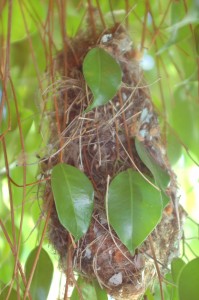
Photo credit: Bobbie Hedges
It’s a promising start when you flip open a book and the words at the top of the page are Long-Tailed Tits.
Reading further it becomes clear that this is actually the common name for the family of birds Aegithalidae, sharing small bodies, short wings and long tails. What a relief, I am reading National Geographic’s Complete Birds of North America and not some poorly executed sexual reading material.
And there is only one species of the Long-Tailed Tits family living in North America, the Bushtit. These names just get better and better! And of course there is no explanation of why “tit” plays such a prominent role in the name. Long-tailed makes sense, the birds have long tails. Bush also makes sense, the Bushtit frequents woods and shrubland; shrub, bush same difference. But this is one mystery I was not willing to let slide!
After much digging I consulted the The Audubon Society Encyclopedia of North American Birds and there the answer was revealed. The scientific name for Bushtit is Psaltriparus minimus and the second half of Psaltriparus, “parus,” is Latin for titmouse. And the “tit” in titmouse comes from Old Icelandic “titr” meaning something small. But who could have guessed how the meaning of the word tit would change hundreds of years later.
Bushtits are cute little puff balls whose fluffy feathers give them a cuddly look. They dress in earth tones with a creamy front, beige head, gray back and taupe wings. This outfit is accessorized by a small stout black bill. Males and females wear the same outfit making them difficult to tell apart.
Usually, Bushtits are easy to spot because they like to hang out in flocks of three to 40 according to The Birds of North America Online database, as they roam about searching for food or huddle together on cold nights to keep warm. Once food is found Bushtits sometimes turn into circus performers hanging upside down to access insects and spiders in hard to reach places.
The Bushtit posse disbands temporarily when mating season begins. And this is when things get interesting.
In order to bring forth the next generation, male and female Bushtits become monogamous for a season. The Sibley Guide to Bird Life & Behavior states, “Bushtit courtship is brief and includes posturing and calling.” This makes it sound like a hurry up, go through the motions and then get down to business type of exchange and that may be because the new couple has to get busy building their nest.
Now I’m not talking about your average bird nest here, I’m talking serious nest construction. The Bushtit nest is really funky looking, like a hanging athletic sock that has the matching sock accidentally stuck inside the toe. Sibley’s describes it as a “large, pendulous sack,” not my top word choice, but you are starting to get the picture.
Both members of the seasonally married couple work on building the nest and even with that level of collaboration the nest can take two weeks to two months to construct. Nice honeymoon.
Nests are made from spider webs and a wide array of plant materials. This could partially explain the long assembly time because it must take forever to manipulate a spider web into doing your bidding without it sticking to you in the process. Once the outside is complete, the nest is lined with feathers and animal hair to make it warm and snuggly. The entrance and exit are a hole left at the top where the couple can fly in and out.
According to The Birds of North America Online database, this sturdy nest also makes the perfect incubator for eggs during the day and the lower half is sometimes placed strategically in the sun to enhance this effect allowing both mom and dad to leave the eggs unattended while they hunt for lunch. The nest’s shape can hold anywhere from five to 15 eggs. Fifteen seems like a lot of eggs for a bird that’s about four inches long, yikes!
Dan Cooper, President of Cooper Ecological Monitoring, Inc. and local bird expert who wrote the book Important Bird Areas of California, vouched for the Bushtit’s reproductive capabilities.
“They do have exceptionally large broods, 10 plus young is not uncommon, said Cooper. “This is very different from most birds aside from waterfowl, quail, and a couple other groups. This adaptation probably allows them to thrive despite their tiny size and delicateness. They’re one of the most successful urban species, nesting in a huge variety of environments, within the most developed neighborhoods. In this way, they’re like pigeons, though 99.99% of the residents of Los Angeles have never seen or heard of them.”
Since you have a very good chance of seeing a Bushtit, if you do spot one while you’re with someone make sure you say, “There’s a Bushtit, a member of the Long-tailed Tits family.” Because seriously when are you going to have the chance again to say “tit” that many times in a sentence without offending somebody?
We have 40-ish tits that visit our feeder, and my teenage kids love yelling “Mom! The Bushtits are here!” Followed by lots of giggling. They finally asked who would ever name them that, and I’m thrilled to find this! Thanks!!!
Your description of the Bushtits outfit is sweet, funny, adorable and memorable.
Thank you for the giggles!
That was useful, thanks. About a year ago I reported my first observation of two Bushtits to a group of serious — so I thought — birders, and was promptly congratulated “for seeing my first pair of tits”.